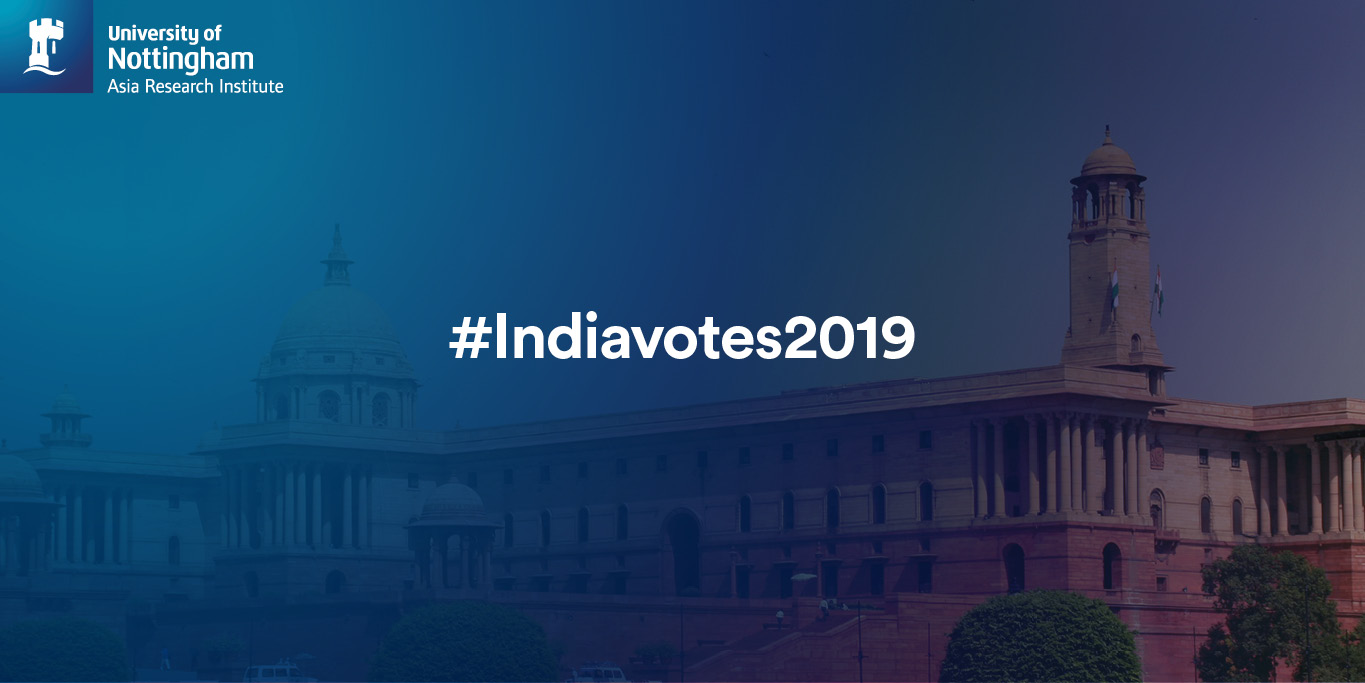Driving commercial and political engagement between Asia, the Middle East and Europe
Driving commercial and political engagement between Asia, the Middle East and Europe
Driving commercial and political engagement between Asia, the Middle East and Europe

Asia House is partnering with the University of Nottingham’s Asia Research Institute to keep you up-to-date on the Indian General Election 2019. Read their analysis on the largest democratic exercise in the world below.
Today is the first polling day in the seven-phase elections. Voters in Andhra Pradesh, Telangana, Uttarakhand, some north eastern states and some Union Territories will go to the polls for their first and only poll date. They will then have to wait six weeks for the results on 23 May. Also today, voters will begin voting in Assam, Bihar, Chhattisgarh, Jammu & Kashmir, Maharashtra, Odisha, Uttar Pradesh, and West Bengal. By the end of the day, the outcomes of one sixth of Lok Sabha seats, or 91 parliamentary constituencies, will have been decided – even though more than five weeks of campaigning across the country are remaining.
This week sees the first phase of polling in the largest election in the world. At the start of the week, the BJP released their manifesto, following the Indian National Congress party’s release of their manifesto, with the former foregrounding national security and the latter prioritising jobs. Voters, political commentators, and journalists will be busy digesting and assessing the messages in these manifestos for some time to come, judging the extent to which parties have captured voters’ concerns and the likelihood that parties will be able to deliver on their promises should they be elected into government. Political parties have also been busy announcing their candidates and seat-sharing alliances, realising some prospective candidates’ aspirations while dashing others’, including incumbent MPs.
Employment issues are high on the election agenda. A survey by the Association for Democratic Reforms of more than 270,000 voters showed that, overall, voters are prioritising employment in both rural and urban areas, as well as hospitals/primary health care centres and drinking water. Rural and urban priorities also vary, with rural voters focusing on agricultural-related concerns like water, loans, prices, and subsidies for seeds/fertilisers, reflecting the rural distress demonstrated by the large scale farmers’ march towards the end of 2018.
The Election Commission have also received several complaints of instances where politicians are alleged to have violated the Model Code of Conduct, and increasing scrutiny over their capacity to respond. On 10 April, the eve of its release, the Election Commission postponed the release of the Narendra Modi biopic until after the elections, concluding it had the ‘potential to disturb the level playing field during the elections’.
Coalitions will be key to this election. The BJP has managed to secure coalition partners in several Indian states, but the Congress Party has not been as successful, such as in Uttar Pradesh where they have been left out of an alliance between the two long term rival parties, the BSP and SP. These two parties have joined together to defeat the BJP, though the Congress party may be able to form post-poll alliances more easily.
A CSDS-Lokniti pre-poll survey has predicted that the BJP will return to power but only as part of a coalition – it won’t win enough seats for a majority on its own. However, we also know that polls can be inaccurate, and that people might overstate their voting preference for the BJP.
This election carries greater significance for the increasing power of women voters, as a result of the closing gender gap in voter turnout over the last few parliamentary elections, enough for one major Indian national news magazine to choose this as their cover story as early as February, before the polling dates were announced. Whether parties are fielding enough women candidates has also been a topic of debate. While the BJP did not manage to pass the Women’s Reservation Bill despite professing support while in opposition, and despite enjoying five years as the majority party in government, regional parties like the TMC in West Bengal and the BJD in Odisha, have nominated a much higher proportion of women candidates. Advocacy organisations, such as the newly founded and non-partisan organisation Political Shakti, have been pressing political parties to field more women, and scholars like Prof. Gilles Verniers and his team at the Trivedi Centre for Political Data have been keeping a tally of candidate nominations.
Also important will be the youth vote, including 45 million new young voters who were not old enough to vote in 2014 and who are hungry for jobs, education, and skill development. But polls (Lokniti) show they are more satisfied with the incumbent Modi government.
Next week (18 April) sees the second polling date, where voters in 13 states and UTs will decide the outcomes of 97 parliamentary constituencies, and for the south Indian state of Tamil Nadu, their only poll date. This year’s election in Tamil Nadu will be less straightforward because of the change in party leadership of the two main rival AIADMK and DMK parties since the last Lok Sabha election in 2014 and the state assembly election in 2016.
Finally, in the coming week, expect to see more media analysis of the two major national parties’ manifesto promises, plus some of the as-yet-undeclared candidate nominations for constituencies with polling dates in subsequent phases. For both today’s and next Thursday’s polling dates, exit polls won’t appear until voting closes on 19 May, but we may get a sense of voter turnout, and there will undoubtedly be more pre-poll survey analysis and campaign developments between now and then.
The University of Nottingham Asia Research Institute is a community of world-leading research comprised of 200 Asia experts across the University’s three campuses (UK, China and Malaysia). View: Blog| Asia Expertise| India Expertise
*This article has been modified in line with Asia House editorial guidelines.
